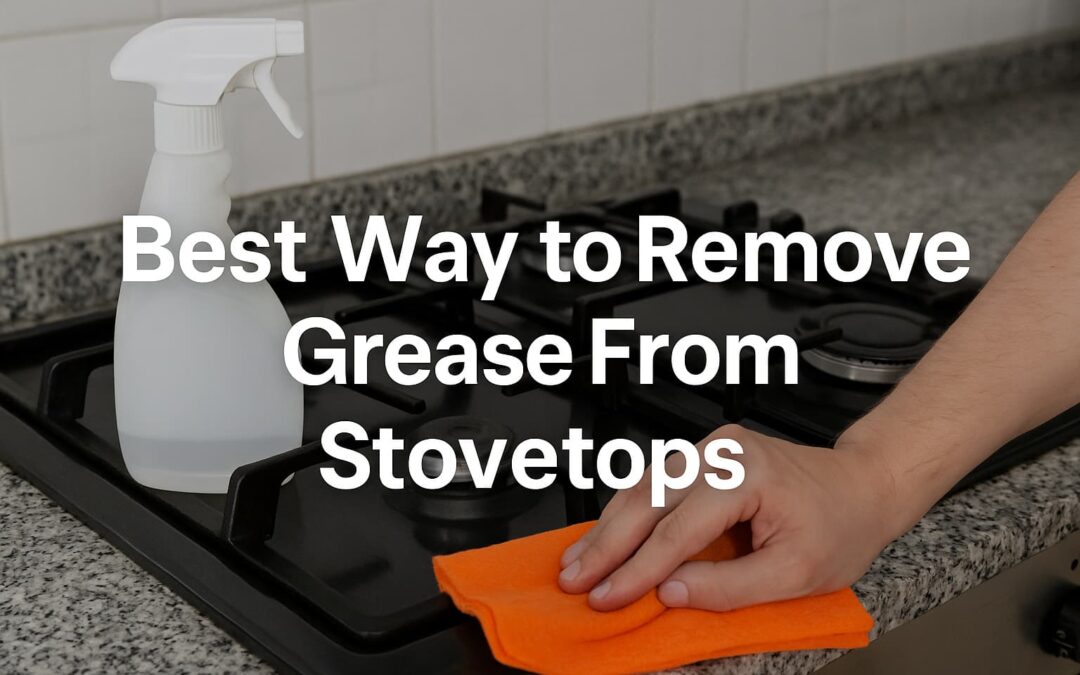Cooking means splatters, and splatters mean grease. Whether you fry bacon, sauté vegetables, or simmer sauces, grease inevitably builds up on stovetops. Over time, it creates sticky layers that are hard to wipe away and can even attract bacteria.
But here’s the catch — scrubbing too hard or using the wrong cleaner can scratch or damage your stovetop surface. The best way to remove grease depends on whether you have a gas, electric, glass, or stainless steel stovetop.
This guide covers safe and effective methods to get rid of grease without ruining your kitchen’s centerpiece.
Key Takeaways
- Always let stovetops cool before cleaning.
- Dish soap + warm water works for daily grease removal.
- Vinegar or lemon water cuts grease naturally (avoid on stone counters nearby).
- Baking soda paste removes stubborn, burnt-on grease.
- Use microfiber cloths or non-abrasive sponges — never steel wool.
Why Is Grease So Hard to Remove From Stovetops?
When oil heats up, it splatters and bonds with dust and food particles. As it cools, it creates a sticky film that hardens over time. The longer it sits, the harder it is to clean.
According to the NSF International study on kitchen hygiene (2023), stovetops are among the top three greasiest surfaces in the average household kitchen, often overlooked in daily cleaning.
How Do You Remove Grease From a Gas Stovetop?
Gas stoves collect grease on both the grates and the flat surface.
Steps:
- Remove grates and soak them in hot, soapy water.
- Wipe stovetop surface with dish soap + warm water.
- For grease spots, spray vinegar-water solution, let sit 10 minutes, then wipe.
- For stubborn buildup, use baking soda paste and scrub gently with a nylon brush.
- Rinse and dry everything before reassembling.
👉 Pro Tip: For heavy grease on grates, place them in a sealed bag with ¼ cup ammonia overnight.
How Do You Remove Grease From an Electric Coil Stovetop?
- Make sure coils are cool and unplug the stove if possible.
- Remove coils carefully and wipe with a damp cloth.
- Use dish soap solution on the stovetop surface.
- Apply baking soda paste to greasy rings, let sit 15 minutes, then wipe.
- Dry coils fully before reattaching.
How Do You Remove Grease From a Glass or Ceramic Stovetop?
These delicate surfaces scratch easily, so avoid abrasives.
Steps:
- Wipe loose crumbs with microfiber cloth.
- Spray vinegar-water solution on grease, let sit 5 minutes.
- For stuck-on grease, sprinkle baking soda, place a damp hot cloth on top, and let sit 15 minutes.
- Wipe clean with soft cloth.
- Polish with vinegar spray for streak-free shine.
👉 Use a plastic scraper if needed, never steel wool.
How Do You Remove Grease From Stainless Steel Stovetops?
Stainless steel shows streaks but cleans well with the right method.
Steps:
- Mix warm water with dish soap. Wipe with microfiber cloth.
- For grease streaks, spray diluted vinegar and wipe with the grain.
- Apply a drop of olive oil or mineral oil to cloth and buff for shine.
Best Natural Grease Fighters
- Dish Soap → Cuts grease molecules instantly.
- Vinegar → Breaks down oil and deodorizes.
- Baking Soda → Lifts hardened grease without scratching.
- Lemon Juice → Works as a natural degreaser (avoid near stone).
- Cornstarch → Absorbs oily residue before wiping.
Comparison Table: Best Grease Removal by Stovetop Type
| Stovetop Type | Best Grease Remover | Avoid |
|---|---|---|
| Gas | Dish soap, vinegar, baking soda | Steel wool |
| Electric | Soap, baking soda paste | Submerging coils in water |
| Glass/Ceramic | Vinegar, baking soda with damp cloth | Abrasives, harsh powders |
| Stainless Steel | Vinegar, soap, buff with oil | Scrubbing against grain |
Common Mistakes to Avoid
- Scrubbing hot surfaces → bakes grease further.
- Using steel wool → leaves scratches.
- Skipping rinse after vinegar → can dull finishes.
- Letting grease sit too long → creates permanent stains.
FAQs
What’s the fastest way to remove grease after cooking?
Wipe immediately with a damp microfiber cloth + dish soap solution.
Can I use commercial degreasers?
Yes, but check labels — many contain harsh chemicals not safe for glass or stainless steel.
Does vinegar remove grease completely?
Yes for light grease. For heavy buildup, combine vinegar with baking soda paste.
How often should I deep clean stovetops?
Daily wipe-downs, with deep cleaning once a week.
Quick Grease Removal Checklist
- Let stovetop cool before cleaning.
- Wipe daily with dish soap solution.
- Use vinegar spray for grease film.
- Use baking soda paste for stubborn spots.
- Dry and polish for streak-free finish.
Final Thoughts
Grease is inevitable, but scratches and stains don’t have to be. The best way to remove grease from stovetops is a combination of dish soap, vinegar, and baking soda, tailored to your stove type. With regular wipe-downs and weekly deep cleaning, you’ll keep your stovetop shiny, safe, and ready for cooking.

As the chief content writer, Hassan Al Sarker works as a professional kitchen-based content creator at Kitchen Liker.
In addition to reviewing the content published on Kitchen Liker, he ensures that it is accurate, relevant, and helpful. As a result, all the reviews and information published at Kitchen Liker are neutral and userfriendly.
Hassan Al Sarker has a bachelor’s degree in Hotel and Tourism Management From the Newyork University. Before joining Kitchen Liker, he was a contributor at Kitchen Club, United States.

